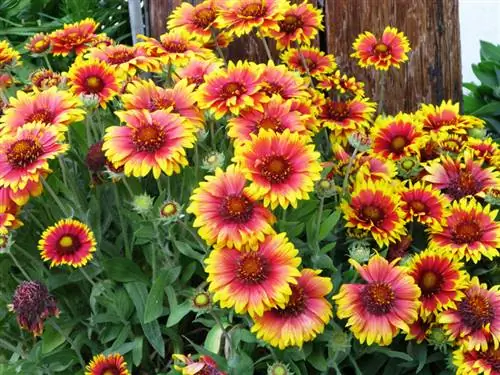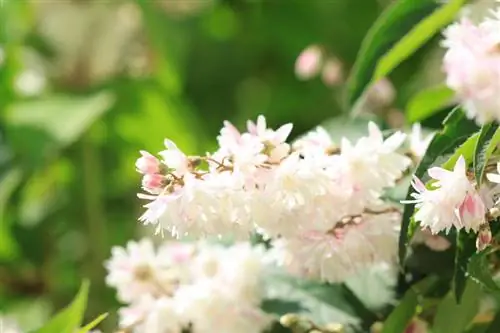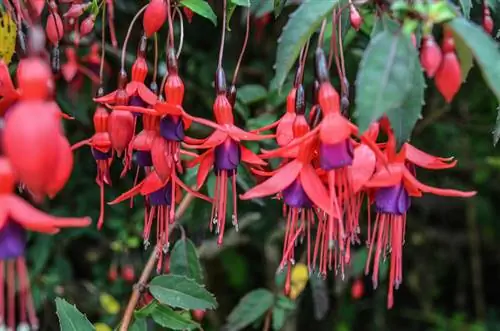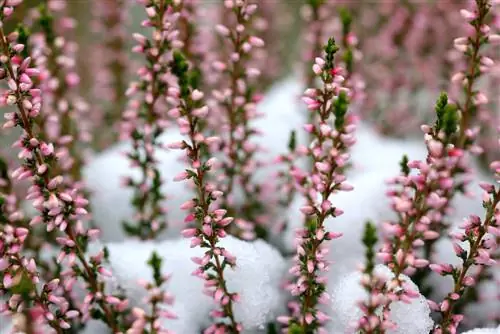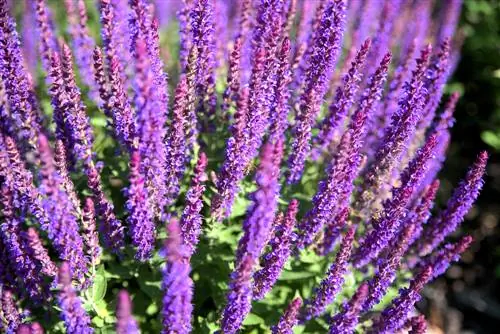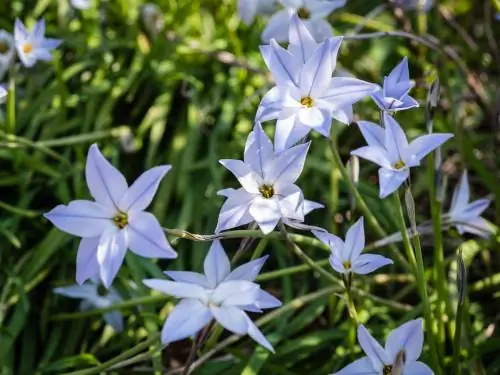- Author admin [email protected].
- Public 2023-12-25 17:45.
- Last modified 2025-01-23 11:20.
The cockade flower presents itself as a tireless, continuous bloomer in the summer garden. In the rock garden, in flower borders and in pots, the floral flame wheels attract everyone's attention. In any sunny spot in your green kingdom, the colorful daisy family members are not above filling gaps. Explore professional cultivation with precise answers to common questions here.
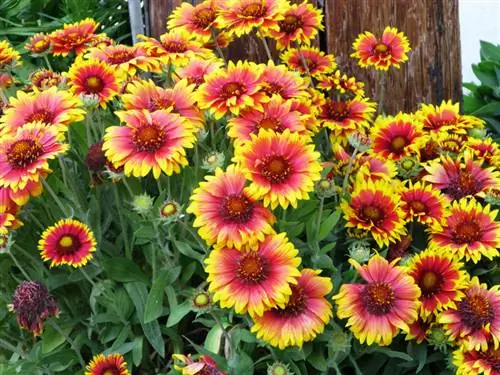
How do I properly care for a cockade flower?
The cockade flower is a colorful perennial bloomer that shines with its bright flower wheels in borders, rock gardens and containers from June to September. Care is simple: water moderately, add compost or liquid fertilizer, clean out wilted flowers and cut the perennial back to the ground in September.
Planting the cockade flower correctly
The departure of the Ice Saints marks the beginning of the planting season for the cockade flower. In a sunny location, dig small planting pits in the sandy, loose soil with 1.5 times the volume of the root ball. A planting distance of 35-40 cm is considered appropriate. You create a picturesque appearance if you arrange the perennials in small tuffs with 10-20 specimens. Place one flower in each hole as deep in the soil as before in the growing container. The addition of compost and horn shavings creates ideal starting conditions for a season full of flowers. No less important is an adequate supply of irrigation water on the day of planting and afterwards.
Care tips
In contrast to the spirited appearance in the bed and pot, the cockade flower is reserved when it comes to care. How to treat the painter's flower correctly:
- Water moderately in dry conditions
- Pamper yourself with compost or liquid fertilizer every 2-3 weeks from May (€18.00 at Amazon) to September
- Clean up wilted flower heads as soon as possible
- At the beginning of September, cut the perennial close to the ground and cover it with leaves
Please do not underestimate the timing of pruning in autumn. If this takes place too late, a Gaillardia will not have enough time to produce the vital winter shoots.read more
Which location is suitable?
The painter's flower achieves its optimum in a sunny, warm and protected location. While the towering varieties don't like a windy location at all, the sturdy 'Kobold' or the delicate 'Bijou' like a place in the sun that is bathed in air.
What soil does the plant need?
You set the course on a flower-rich course if you plant the cockade flower in loose, humus-rich and sandy-loamy soil. Given this requirement, it is hardly surprising that the perennial feels extremely comfortable in the rock garden or steppe bed. Correspondingly, a potting soil with sand or fine grit should be considered as a potting substrate, ideally enriched with lava granules or perlite respiration flakes.
When is flowering time?
From June to September, the cockade flower beats its floral pinwheels in the bed and on the balcony. Since a single flower does not have this staying power, clean out wilted basket flowers regularly. In this way, the well-groomed appearance is maintained and the flowering period extends into autumn.
Cutting the cockade flower correctly
The experienced hobby gardener always has secateurs at hand when he visits his cockade flowers. On these occasions the picturesque summer flower is cut:
- As a vase decoration in the morning hours when the flowers have just opened
- Cleaning out wilted flowers to make room for rebloom
- Pruning close to the ground at the beginning/mid of September
The final cut is also one of the most important care measures. In this way you encourage a Gaillardia to replant before winter. Without this tuft of leaves, the flower will not get through the cold season unscathed.read more
Watering the cockade flower
Water a cockade flower moderately. If in doubt, the summer beauty would rather stay dry for a short time than deal with waterlogging. Apply water slowly to the root ball so that you can recognize in good time when no more moisture is being absorbed. You can tell from potted flowers when the first drops run into the saucer.
Fertilize the cockade flower properly
In the bed, the cockade flower gratefully accepts a portion of compost with horn shavings every 3-4 weeks. The application of fertilizer ends with pruning before winter. The same applies to potted flowers. From May (€18.00 on Amazon) to September, administer a liquid fertilizer for flowering plants every 2 weeks. There is no nutrient supply in the winter quarters between October and April.
Wintering
The pivotal point of successful wintering is sharp pruning in autumn at the right time. At the beginning/mid of September, cut the cockade flower back to the ground. The perennial then replants and the vital overwintering shoots form. If this cutting date is missed, a Gaillardia's chances of survival decrease dramatically. We also recommend covering it with leaves or straw to protect it from constant wetness and bitter cold. Please put pots with a diameter of less than 30 cm in the frost-free winter quarters. Larger planters receive a winter coat made of fleece, jute or bubble wrap as well as a warm base made of wood.
Propagate cockade flower
If you are aiming for varietal propagation, the focus is on dividing the root ball. The best time to do this is in spring when the ground has completely thawed. However, if you are planning a larger number of cockade flowers, sowing the seeds makes more sense. Certified seeds from specialist retailers ensure which attributes the flowers have. Sown on peat sand, just press the light germinators and shower them with soft water. At a constant 20 degrees Celsius, the first cotyledons emerge after 10-14 days. For further care, place the seedlings a little cooler at 16-18 degrees Celsius. By mid-May you will have numerous vital cockade flowers in your hands, strong enough for planting.
How do I transplant correctly?
Pick up the root ball every 3-4 years to replant it after division. This measure makes a significant contribution to ensuring that the cockade flower remains as a perennial for a long time. A suitable date is in spring, as soon as there is no longer any threat of frost. Cut the plant into two or more parts. Each segment with 2-3 eyes has the potential to become an adult painter's flower.
Cockade flower in pot
In the pot and balcony box, the painter's flowers spread their colorful fireworks in a sunny, warm and protected location. Fill in a loose potting soil enriched with quartz sand and perlite over a water-bearing layer of pebbles or pottery shards. The planting depth in the cultivation container should be maintained as much as possible. Water the painter's flower only moderately. From May (€18.00 at Amazon) to September, pamper the fiery flowering beauty with liquid fertilizer every two weeks. At the beginning of September, cut the perennial close to the ground to move it to its frost-free winter quarters.
Beautiful varieties
- Burgundy: Magnificent cockade flower that creates colorful eye-catchers with its deep red flower wheels; 50-60cm
- Tokaji: Majestic painter's flower with orange flowers, ideal as a backdrop plant in a perennial bed; 70-80cm
- Kobold: A stable variety with red, yellow ray flowers for beds and balconies; 30-40cm
- Arizona Sun: Beautiful and colorful, like a sunset; Gold medal variety from 2006; 20-30cm
- Amber Wheels: Predominantly yellow-flowering Gaillardia that shines in competition with the sun; 60-70cm
- Bijou: The smallest jewel among the cockade flowers, with semi-double flowers in red, yellow and scarlet; 25cm

